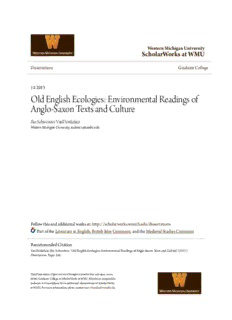
Environmental Readings of Anglo-Saxon Texts and Culture PDF
Preview Environmental Readings of Anglo-Saxon Texts and Culture
WWeesstteerrnn MMiicchhiiggaann UUnniivveerrssiittyy SScchhoollaarrWWoorrkkss aatt WWMMUU Dissertations Graduate College 12-2013 OOlldd EEnngglliisshh EEccoollooggiieess:: EEnnvviirroonnmmeennttaall RReeaaddiinnggss ooff AAnngglloo--SSaaxxoonn TTeexxttss aanndd CCuullttuurree Ilse Schweitzer VanDonkelaar Western Michigan University, [email protected] Follow this and additional works at: https://scholarworks.wmich.edu/dissertations Part of the Literature in English, British Isles Commons, and the Medieval Studies Commons RReeccoommmmeennddeedd CCiittaattiioonn VanDonkelaar, Ilse Schweitzer, "Old English Ecologies: Environmental Readings of Anglo-Saxon Texts and Culture" (2013). Dissertations. 216. https://scholarworks.wmich.edu/dissertations/216 This Dissertation-Open Access is brought to you for free and open access by the Graduate College at ScholarWorks at WMU. It has been accepted for inclusion in Dissertations by an authorized administrator of ScholarWorks at WMU. For more information, please contact [email protected]. OLD ENGLISH ECOLOGIES: ENVIRONMENTAL READINGS OF ANGLO-SAXON TEXTS AND CULTURE by Ilse Schweitzer VanDonkelaar A dissertation submitted to the Graduate College in partial fulfillment of the requirements for the degree of Doctor of Philosophy Department of English Western Michigan University December 2013 Doctoral Committee: Jana K. Schulman, Ph.D., Chair Eve Salisbury, Ph.D. Richard Utz, Ph.D. Sarah Hill, Ph.D. OLD ENGLISH ECOLOGIES: ENVIRONMENTAL READINGS OF ANGLO-SAXON TEXTS AND CULTURE Ilse Schweitzer VanDonkelaar, Ph.D. Western Michigan University, 2013 Conventionally, scholars have viewed representations of the natural world in Anglo-Saxon (Old English) literature as peripheral, static, or largely symbolic: a “backdrop” before which the events of human and divine history unfold. In “Old English Ecologies,” I apply the relatively new critical perspectives of ecocriticism and place- based study to the Anglo-Saxon canon to reveal the depth and changeability in these literary landscapes. Overall, this interdisciplinary study of Anglo-Saxon texts brings together literary and environmental sources and modes of inquiry to explore the place of humans (and non-humans) within the natural environments of Anglo-Saxon England, as well as the ways in which natural cycles and processes are reflected in Anglo-Saxon literature and culture. Looking to Old English scriptural, hagiographical, epic, gnomic, and elegiac poetry, as well as homilies, prayers, and philosophical and didactic works, I locate imagined or figurative landscapes in these texts. Employing ecocritical theory, I find intersections between these figurative spaces—the mead-hall, the conventional “center” of human society in the Anglo-Saxon world, as well as the lonely worlds of exile (water, wood, and wilderness), and the grave, the earthly body’s final “home”—and their actual counterparts. Ultimately, the project confronts the conventional reading of the Anglo-Saxon worldview of earth’s impending and inevitable decay with evidence that cyclical and seasonal views of time pervade the works of the period. By juxtaposing my ecological readings with archaeological reports and landscape histories, I am able to expose the paradoxes of finding one’s literary, actual, and ecological place(s) in an Anglo-Saxon landscape that is always in flux, yet trapped in stasis. © 2013 Ilse Schweitzer VanDonkelaar ACKNOWLEDGEMENTS First, many thanks to my excellent committee: Dr. Jana Schulman, Dr. Eve Salisbury, Dr. Richard Utz, and Dr. Sarah Hill, for agreeing to see me through to the end of this project, for their support, and for their insightful commentary. I am especially grateful to Eve, for her thoughtful feedback throughout my writing process, and to Jana, for reading through what felt like a thousand chapter drafts and for helping me to write the dissertation I wanted to write. Second, I am extremely grateful to the WMU Department of English and to the WMU Graduate College for finding and providing assistantships and financial support for me beyond what I deserved. To my friends and colleagues who provided support of another kind — thanks to Dr. Karen Vocke, Chris Triezenberg, Theresa Whitaker, Dr. Lisa Horton, Greg Laing, Adrienne Redding, and Jamie McCandless for emotional support and for applying peer pressure in the form of dissertation writing groups. Finally, more thanks than I can express to my family, Joan Wiley Schweitzer, Robert Schweitzer, and Eden Schweitzer, who encouraged me to finish. And, of course, to my husband, Dr. Curtis VanDonkelaar, who kept me (relatively) sane through this process and who keeps reminding me, “see... I told you could do it.” Ilse Schweitzer VanDonkelaar ii TABLE OF CONTENTS ACKNOWLEDGEMENTS.................................................................................................ii LIST OF FIGURES............................................................................................................vi CHAPTER I. INTRODUCTION: AN ARGUMENT FOR ECO-ANGLO-SAXONISM............1 Background and Methodology...........................................................................3 Definitions........................................................................................................13 Chapter Summaries..........................................................................................16 II. NO PLACE LIKE HOME.....................................................................................23 Cosmic Hall, Communal Home.......................................................................24 Limitations of Mixed Literary and Archaeological Studies............................31 A Guest is in the Hall.......................................................................................33 Hall and Home, Farm and Field.......................................................................38 Verbal Transformations in Agricultural Literature..........................................47 Entertainment, Edification, Exchange, Escape?..............................................59 III. THE ORDER OF THINGS...................................................................................78 Ordering the World..........................................................................................80 Everything in its Place.....................................................................................85 Poetic Architecture...........................................................................................93 Slipping Out of Place.....................................................................................102 Moving Through Time...................................................................................115 iii Table of Contents—Continued CHAPTER Orderly Performance......................................................................................120 There and Back Again...................................................................................124 IV. THE PATHS OF EXILE.....................................................................................127 Exile as Universal..........................................................................................129 The Poetry of Exile........................................................................................133 I Wonder as I Wander....................................................................................137 The Song of Myself.......................................................................................148 Ofer hwæles eþel: the Whale’s Home, the Human’s Home..........................156 Paths Without End.........................................................................................170 V. INTO THE WILD................................................................................................174 Guthlac’s Westen...........................................................................................182 A Wilderness of Wanderers..........................................................................190 “A Hideous Fen of a Huge Bigness”.............................................................196 Centering the Margins....................................................................................205 Wilderness and Exile.....................................................................................209 VI. FINAL DESTINATIONS....................................................................................218 Bodily Breakdown.........................................................................................221 Houses of Bone..............................................................................................235 The Homely Grave.........................................................................................239 What Remains................................................................................................249 Linear and Cyclical Time...............................................................................261 iv Table of Contents—Continued CHAPTER Enigmatic Creation........................................................................................267 Circling Back.................................................................................................276 VII. CONCLUSIONS........................................................................................... ......278 BIBLIOGRAPHY............................................................................................................285 v LIST OF FIGURES 1. Guthlac and Tatwine travel by boat. From Harleian Guthlac Roll Y.6. ...................216 2. Guthlac and Pega. From Harleian Guthlac Roll Y.6. ...............................................216 3. East Anglian fenlands. Taken from Della Hooke, The Landscape of Anglo-Saxon England, p. 172, based on the work of Hall and Coles. .......................................................................217 vi
Description: